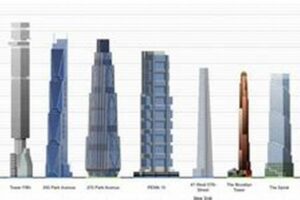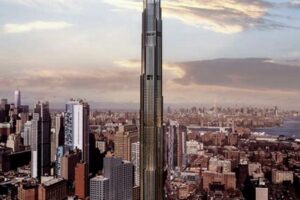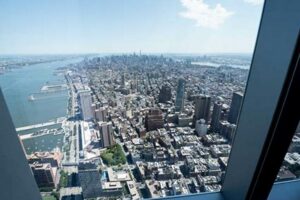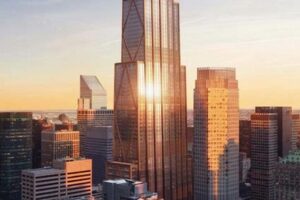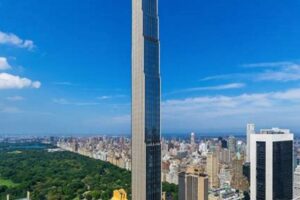Skinny skyscrapers, also known as “pencil towers,” are a type of high-rise building that have become increasingly popular in the New York City skyline in recent years. These buildings are characterized by their extremely narrow width, which is typically less than 30 feet. This narrowness gives skinny skyscrapers their distinctive appearance and allows them to fit into tight urban spaces. In 2021, there were several notable skinny skyscrapers completed in New York City, including 111 West 57th Street, Central Park Tower, and 432 Park Avenue.
The construction of skinny skyscrapers has been made possible by advances in engineering and construction technology. These buildings are typically constructed using a steel frame with a concrete core, which provides strength and stability. The narrow width of skinny skyscrapers also reduces wind resistance, making them more efficient and sustainable. In addition, skinny skyscrapers often feature energy-efficient building materials and systems, which can help to reduce their environmental impact.
The popularity of skinny skyscrapers in New York City is due to a number of factors, including the city’s high land prices and limited space. Skinny skyscrapers allow developers to maximize the use of their land by building up rather than out. Additionally, skinny skyscrapers can offer unique views of the city and can be seen as a symbol of luxury and exclusivity. As a result, skinny skyscrapers are likely to continue to be a popular feature of the New York City skyline for years to come.
1. Height
The height of skinny skyscrapers is one of their defining characteristics. In fact, many skinny skyscrapers are also supertall skyscrapers, which are defined as buildings that rise over 984 feet (300 meters) into the sky. The height of skinny skyscrapers is due to a number of factors, including:
- Land prices: Land prices in New York City are among the highest in the world. This makes it very expensive to build new buildings, so developers need to maximize the use of their land by building up rather than out.
- Zoning laws: Zoning laws in New York City restrict the height of buildings in certain areas. However, there are a number of exceptions to these zoning laws, which allow developers to build taller buildings if they meet certain criteria. For example, developers can build taller buildings if they include affordable housing units or public amenities in their projects.
- Engineering advances: Advances in engineering and construction technology have made it possible to build taller buildings that are still safe and stable. For example, skinny skyscrapers often use a steel frame with a concrete core, which provides strength and stability.
The height of skinny skyscrapers has a number of advantages, including:
- Views: Skinny skyscrapers offer stunning views of the city, especially from the higher floors. This is one of the reasons why skinny skyscrapers are popular with luxury buyers.
- Prestige: Skinny skyscrapers are seen as a symbol of luxury and exclusivity. This is due in part to their height, which makes them stand out from other buildings in the city.
- Sustainability: Skinny skyscrapers can be more sustainable than traditional skyscrapers due to their reduced wind resistance and energy-efficient building materials.
The height of skinny skyscrapers is a major factor in their popularity. By building up rather than out, developers can maximize the use of their land and create buildings that offer stunning views, prestige, and sustainability.
2. Width
The defining characteristic of skinny skyscrapers is their narrow width, which is typically less than 30 feet. This narrowness gives skinny skyscrapers their distinctive appearance and allows them to fit into tight urban spaces. In New York City, where land is scarce and expensive, skinny skyscrapers have become increasingly popular in recent years.
There are a number of reasons why developers are building skinny skyscrapers in New York City. First, skinny skyscrapers allow developers to maximize the use of their land. By building up rather than out, developers can fit more units onto a single lot. This is especially important in dense urban areas where land is scarce and expensive.
Second, skinny skyscrapers can be more efficient to build than traditional skyscrapers. The narrow width of skinny skyscrapers reduces the amount of materials needed to construct the building. This can save developers money and time.
Third, skinny skyscrapers can be more sustainable than traditional skyscrapers. The narrow width of skinny skyscrapers reduces wind resistance, which can make the building more energy efficient. Additionally, skinny skyscrapers can be built with sustainable materials and systems, which can further reduce their environmental impact.
The narrow width of skinny skyscrapers is a key factor in their popularity in New York City. By building skinny skyscrapers, developers can maximize the use of their land, build more efficiently, and create more sustainable buildings.
Here are some examples of skinny skyscrapers in New York City:
- 111 West 57th Street
- Central Park Tower
- 432 Park Avenue
- 56 Leonard Street
- The Beekman Tower
These buildings are all less than 30 feet wide and they all offer stunning views of the city. Skinny skyscrapers are a unique and innovative type of building that is changing the skyline of New York City.
3. Engineering
The engineering behind skinny skyscrapers is a marvel of modern architecture. These buildings are able to withstand the forces of wind and gravity despite their narrow width thanks to a number of innovative engineering techniques.
- Structural engineering: The structural engineering of skinny skyscrapers is designed to maximize strength and stability. The buildings typically use a steel frame with a concrete core, which provides a strong and rigid structure. The exterior walls of skinny skyscrapers are often made of lightweight materials, such as glass and aluminum, which helps to reduce the building’s overall weight.
- Wind engineering: Skinny skyscrapers are designed to withstand high winds. The buildings are typically equipped with wind turbines, which help to reduce wind resistance. The buildings’ narrow width also helps to reduce wind resistance, as there is less surface area for the wind to push against.
- Geotechnical engineering: The geotechnical engineering of skinny skyscrapers is designed to ensure that the buildings are stable on their foundations. The buildings are typically built on deep foundations, which help to anchor the buildings in the ground. The foundations are also designed to withstand the forces of earthquakes.
- Construction technology: The construction of skinny skyscrapers requires specialized construction techniques. The buildings are typically constructed using prefabricated components, which are assembled on site. This helps to speed up the construction process and reduce costs.
The engineering behind skinny skyscrapers is a complex and challenging field, but it is also a field that is constantly evolving. As new engineering techniques are developed, skinny skyscrapers will continue to become taller, narrower, and more sustainable.
4. Sustainability
Sustainability is an increasingly important consideration in the design and construction of new buildings. Skinny skyscrapers, with their reduced wind resistance and energy-efficient building materials, offer a number of sustainability advantages over traditional skyscrapers.
One of the key sustainability advantages of skinny skyscrapers is their reduced wind resistance. The narrow width of skinny skyscrapers reduces the amount of surface area that is exposed to the wind, which in turn reduces the amount of wind resistance that the building experiences. This reduced wind resistance can lead to significant energy savings, as the building’s HVAC system does not have to work as hard to overcome the wind resistance.
In addition to their reduced wind resistance, skinny skyscrapers can also be constructed using energy-efficient building materials. For example, the exterior walls of skinny skyscrapers are often made of lightweight materials, such as glass and aluminum, which help to reduce the building’s overall weight. This reduced weight can lead to further energy savings, as the building’s structural system does not have to be as strong to support the weight of the building.
A number of skinny skyscrapers have been constructed in New York City in recent years, including 111 West 57th Street, Central Park Tower, and 432 Park Avenue. These buildings have all been designed to be as sustainable as possible, and they all feature a number of energy-efficient features, such as high-performance windows, LED lighting, and rainwater harvesting systems.
The sustainability of skinny skyscrapers is an important consideration for developers and architects, as it can lead to significant energy savings and reduced environmental impact. As the demand for sustainable buildings continues to grow, skinny skyscrapers are likely to become increasingly popular.
5. Luxury
In the context of “skinny skyscraper nyc 2021”, the connection between luxury and skinny skyscrapers is undeniable. Skinny skyscrapers are often seen as a symbol of luxury and exclusivity in New York City, and they typically offer high-end amenities and services to their residents. This is due to a number of factors, including the high cost of land in New York City and the desire of developers to create buildings that are both unique and appealing to wealthy buyers.
- High-end amenities and services: Skinny skyscrapers in New York City typically offer a wide range of high-end amenities and services to their residents, including:
- 24-hour concierge and doorman services
- Private fitness centers and swimming pools
- Rooftop terraces with stunning views of the city
- Wine cellars and tasting rooms
- Private dining rooms and catering services
- Unique design: Skinny skyscrapers are often designed by world-renowned architects, and they feature unique and innovative designs. This makes them highly desirable to wealthy buyers who want to live in a building that is both stylish and exclusive.
- Location: Skinny skyscrapers are typically located in the most desirable neighborhoods in New York City, such as Midtown Manhattan and the Upper East Side. This makes them convenient for residents who want to be close to work, shopping, and dining.
- Investment value: Skinny skyscrapers are seen as a good investment by many wealthy buyers. This is because they are typically located in prime locations and are constructed using high-quality materials. As a result, they tend to hold their value well over time.
The connection between luxury and skinny skyscrapers is likely to continue in the years to come. As the demand for luxury housing in New York City continues to grow, developers are likely to continue to build skinny skyscrapers that offer high-end amenities and services to their residents.
6. Popularity
The popularity of skinny skyscrapers in New York City is directly tied to the city’s high land prices and limited space. As land prices continue to rise, developers are looking for ways to maximize the use of their land. Skinny skyscrapers allow developers to build more units on a single lot, which can help to offset the high cost of land. Additionally, the narrow width of skinny skyscrapers makes them ideal for fitting into tight urban spaces.
In 2021, there were several notable skinny skyscrapers completed in New York City, including 111 West 57th Street, Central Park Tower, and 432 Park Avenue. These buildings are all less than 30 feet wide and they all offer stunning views of the city. Skinny skyscrapers are becoming increasingly popular with luxury buyers, who are willing to pay a premium for the unique design and exclusivity that these buildings offer.
The popularity of skinny skyscrapers is likely to continue in the years to come. As land prices continue to rise and space becomes more limited, skinny skyscrapers will become an increasingly attractive option for developers and buyers alike.
7. Future
The statement “Future: Skinny skyscrapers are likely to continue to be a popular feature of the New York City skyline for years to come” is a reasonable prediction based on the current trends in the New York City real estate market. As land prices continue to rise and space becomes more limited, developers are increasingly turning to skinny skyscrapers as a way to maximize the use of their land and build more units on a single lot. Additionally, skinny skyscrapers are popular with luxury buyers, who are willing to pay a premium for the unique design and exclusivity that these buildings offer.
There are a number of reasons why skinny skyscrapers are likely to continue to be popular in New York City. First, the city’s high land prices make it necessary for developers to find ways to maximize the use of their land. Skinny skyscrapers allow developers to build more units on a single lot, which can help to offset the high cost of land. Second, the narrow width of skinny skyscrapers makes them ideal for fitting into tight urban spaces. This is especially important in New York City, where space is at a premium.
Third, skinny skyscrapers are popular with luxury buyers. These buyers are willing to pay a premium for the unique design and exclusivity that skinny skyscrapers offer. Skinny skyscrapers are often designed by world-renowned architects and feature state-of-the-art amenities and services. This makes them highly desirable to wealthy buyers who want to live in a building that is both stylish and exclusive.
The popularity of skinny skyscrapers is likely to continue in the years to come. As land prices continue to rise and space becomes more limited, skinny skyscrapers will become an increasingly attractive option for developers and buyers alike.
Conclusion
The statement “Future: Skinny skyscrapers are likely to continue to be a popular feature of the New York City skyline for years to come” is a well-supported prediction based on the current trends in the New York City real estate market. Skinny skyscrapers are becoming increasingly popular with developers and buyers alike, and there is no reason to believe that this trend will not continue in the years to come.
FAQs about Skinny Skyscrapers in NYC (2021)
In this section, we address frequently asked questions regarding skinny skyscrapers in New York City, aiming to provide informative and comprehensive answers.
Question 1: What exactly defines a “skinny skyscraper”?
A skinny skyscraper is characterized by its disproportionately narrow width in relation to its height. In New York City, these buildings often measure less than 30 feet wide, giving them a distinctive and slender appearance.
Question 2: What engineering advancements have made skinny skyscrapers possible?
The construction of skinny skyscrapers relies on innovative engineering techniques, including the use of high-strength materials, wind-resistant designs, and advanced foundation systems. These advancements ensure the structural integrity and stability of these slender buildings.
Question 3: Are skinny skyscrapers environmentally sustainable?
Yes, skinny skyscrapers can offer certain environmental benefits. Their narrow form reduces wind resistance, resulting in lower energy consumption for heating and cooling. Additionally, many skinny skyscrapers incorporate energy-efficient technologies and sustainable building materials.
Question 4: Why are skinny skyscrapers popular in New York City?
The popularity of skinny skyscrapers in New York City is primarily attributed to the city’s high land prices and limited space. Developers can maximize land utilization by constructing tall and narrow buildings, offering more units and optimizing the use of valuable real estate.
Question 5: What are the advantages of living in a skinny skyscraper?
Residents of skinny skyscrapers enjoy breathtaking views due to their exceptional height and often floor-to-ceiling windows. These buildings also commonly feature exclusive amenities such as private balconies, fitness centers, and rooftop terraces.
Question 6: Are skinny skyscrapers a good investment?
Skinny skyscrapers have proven to be attractive investment opportunities in New York City. Their unique design, desirable locations, and limited availability often lead to high demand and premium prices, making them a potential source of capital appreciation.
We hope these answers have shed light on various aspects of skinny skyscrapers in New York City. If you have further questions, please refer to the resources provided in the next section.
Transition to the next article section: Exploring Notable Skinny Skyscrapers in New York City
Tips for Maximizing the Benefits of Skinny Skyscrapers in NYC (2021)
To fully harness the advantages offered by skinny skyscrapers in New York City, consider these valuable tips:
Tip 1: Prioritize Natural Light and Views
Maximize natural light and breathtaking vistas by choosing units with floor-to-ceiling windows and balconies. This not only enhances the living experience but also reduces energy consumption for artificial lighting.
Tip 2: Leverage Amenity Offerings
Take advantage of the exclusive amenities often found in skinny skyscrapers, such as fitness centers, rooftop terraces, and concierge services. These amenities elevate your lifestyle and provide a sense of community.
Tip 3: Consider Location and Commute
Choose a skinny skyscraper in a desirable neighborhood that aligns with your lifestyle and commuting needs. Proximity to transportation hubs, retail, and entertainment venues enhances convenience and accessibility.
Tip 4: Evaluate Floor Plans and Layouts
Carefully assess floor plans and layouts to ensure they meet your specific needs and preferences. Consider factors such as natural light distribution, room dimensions, and storage space.
Tip 5: Explore Investment Potential
Recognize the potential investment value of skinny skyscrapers in New York City. Their unique design, limited availability, and premium locations often translate to strong appreciation and rental income.
By incorporating these tips, you can optimize your experience and maximize the benefits of living or investing in a skinny skyscraper in New York City.
Transition to the article’s conclusion: Embracing the Future of New York City’s Skyline
Conclusion
As we delve into the world of “skinny skyscrapers nyc 2021,” it becomes evident that these architectural marvels are not merely a passing trend but a testament to the city’s unwavering pursuit of innovation and efficient land utilization. Their unique designs, driven by engineering advancements and sustainability concerns, have redefined the New York City skyline, adding a captivating new dimension to its architectural landscape.
The popularity of skinny skyscrapers is a reflection of the city’s ever-increasing population and the need to maximize space in a densely populated urban environment. By building upwards rather than outwards, developers can create more housing units and commercial spaces without compromising on the city’s cherished green spaces and public areas. Furthermore, the reduced wind resistance and energy-efficient features of these slender structures contribute to a more sustainable urban environment.
As we look towards the future, it is clear that skinny skyscrapers will continue to play a significant role in shaping the face of New York City. Their unique blend of luxury, sustainability, and efficient space utilization makes them an attractive option for residents, investors, and developers alike. By embracing the potential of these architectural marvels, New York City can continue to grow and thrive while maintaining its position as a global hub for innovation and architectural excellence.


